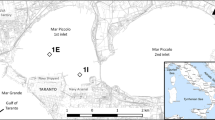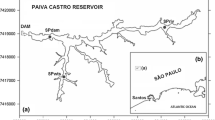Abstract
This study employs chemical fractionations of sedimentary metals and analyses of sediment arcellacean (thecamoebian) faunas to study the ecological effects of mining wastewaters in a boreal lake bay that receives metal-rich waters from a Cu mine. Sediment chemistry and arcellacean species compositions were analyzed from both surface sediment samples and a sediment profile to investigate spatial and temporal changes in mine water pollution and biota. Based on the results, geochemical gradients in the area are caused by dispersal and dilution of metal-rich, low-pH mine waters entering the lake; transport and focusing of fine grained metal precipitates and sulphate in the deep areas of the bay; increase in pH due to sulphate reduction and mobilization of redox-sensitive elements from deep water sites; and precipitation of the mobilized metals at shallower sites. Arcellacean species compositions change systematically with increasing distance from the source of pollution and species diversity as well as concentrations of tests in the samples increase as well. Fe:Mn ratio and adsorbed Al explained variation in surface sediment arcellaceans with statistical significance. Fe:Mn ratio is an indicator of the overall geochemical environment (Eh, pH), while the toxicity of Al in aquatic environments is well known. Changes in arcellacean species and geochemistry in the long core suggest that before the mine closure in 1983, mine waters differed in nature from the present acid drainage and metals such as Cu, Co, Zn and Ni may have affected arcellaceans at that time.
Similar content being viewed by others
References
Asioli, A., Medioli, F. S. and Patterson, R. T.: 1996, ‘Thecamoebians as a tool for reconstruction of paleoenvironments in some italian lakes in the foothills of the southern Alps (Orta, Varese and Candia)’, J. Foraminiferal Res. 26, 248–263.
Beyens, L. and Meisterfeld, R.: 2001, ‘Protozoa: Testate amoebae’, in J. P. Smol, H. J. B. Birks and W. M. Last (eds.), Tracking Environmental Change Using Lake Sediments. Volume 3: Terrestrial, Algal, and Siliceous Indicators, Kluwer Academic Publishers, Dordrecht, The Netherlands, pp. 121–153.
Booth, R. K.: 2002, ‘Testate amoebae as paleoindicators of surface-moisture changes on Michigan peatlands: Modern ecology and hydrological calibration’, J. Paleolim. 28, 329–348.
Boudreau, R. E. A., Galloway, J. M., Patterson, R. T., Kumar, A. and Michel, F. A.: 2005, ‘A paleolimnologic record of Holocene climate and environmental change in the Temagami region, notheastern Ontario’, J. Paleolim. 33, 445–461.
Dalby, A. P., Kumar, A., Moore, J. M. and Patterson, R. T.: 2000, ‘Preliminary survey of arcellaceans (thecamoebians) as limnological indicators in tropical Lake Sentani, Irian Jaya, Indonesia’, J. Foraminiferal Res. 30, 135–142.
Ellison, R. L.: 1995, ‘Paleolimnological analysis of Ullswater using testate amoebae’, J. Paleolim. 23, 51–63.
Eskelinen, E., Huopaniemi, P. and Tyni, M.: 1983, ‘Myllykoski Oy:n Luikonlahden kuparikaivos 1968–1983. Summary: The 100 years' history of the Luikonlahti copper mine of Myllykoski Ltd’, Vuoriteollisuus 41, 94–98.
Hammer, Ø., Harper, D. A. T. and Ryan, P. D.: 2001, ‘Past: Paleontological statistics software package for education and data analysis’, Palaeontologia Electronica 4, issue 1, article 4, 9 pp. http://palaeo-electronic.org/2001_1/past/issue1_01.htm
Kansanen, P. H., Jaakkola, T., Kulmala, S. and Suutarinen, R.: 1991, ‘Sedimentation and distribution of gamma-emitting radionuclides in bottom sediments of southern Lake Päijänne, Finland, after the Chernobyl accident’, Hydrobiologia 222, 121–140.
Koljonen, T. (ed.): 1992, The Geochemical Atlas of Finland. Part 2: Till, Geological Survey of Finland, Espoo, 218 pp.
Kumar, A. and Patterson, R. T.: 2000, ‘Arcellaceans (thecamoebians): new tools for monitoring long- and short-term changes in lake bottom acidity’, Env. Geol. 39, 689–697.
Medioli, F. S. and Scott, D. B.: 1983, ‘Holocene arcellacea (thecamoebians) from eastern Canada’, Cushman Foundation for Foraminiferal Research Special Publication 21, 63 pp.
Mikkonen, K. and Häikiö, M.: 2004, Lausunto. Dnro 0696 Y 0109 – 11, Report, Regional Environment Centre of North Savo, 12 pp.
Patterson, R. T., Dalby, A., Kumar, A., Henderson, L. A. and Boudreau, R. E. A.: 2002, ‘Arcellaceans (thecamoebians) as indicators of land use change: Settlement history of the Swan Lake area, Ontario as a case study’, J. Paleolim. 28, 297–316.
Patterson, R. T. and Kumar, A.: 2000a, ‘Use of Arcellacea (Thecamoebians) to Gauge Levels of Contamination and Remediation in Industrially Polluted Lakes’, in R.E. Martin (ed.), Environmental Micropaleontology, Volume 15, Topics in Geobiology, Kluwer Academic/Plenum Publishers, New York, pp. 257–277.
Patterson, R. T. and Kumar, A.: 2000b, ‘Assessment of arcellacean (thecamoebian) assemblages, species and strains as contaminant indicators in variably contaminated James Lake, northeastern Ontario’, J. Foraminiferal Res. 30, 310–320.
Patterson, R. T. and Kumar, A.: 2002, ‘A review of current testate rhizopod (thecamoebian) research in Canada’, Palaeogeography, Palaeoclimatology, Palaeoecology 180, 225–251.
Patterson, R. T., Barker, T. and Burbidge, S. M.: 1996, ‘Arcellaceans (thecamoebians) as proxies of arsenic and mercury contamination in northeastern Ontario lakes’, J. Foraminiferal Res. 26, 172–183.
Putkinen, S. and Saarelainen, J.: 1998, ‘Kullenbergin näytteenottimen uusi kevennetty malli’, Geologi 50, 22–23.
Räisänen, M. L.: 2003, ‘Kaavin rikastushiekka-altaan ympäristön nykytila ja suositukset jälkihoitotoimenpiteille. Assessment of the environmental state of the tailings facility and its surroundings, Kaavi talc plant, and recommendations for decommissioning (In Finnish with English summary)’, unpublished report, Geological Survey of Finland, Kuopio Unit, 42 pp.
Räisänen, M. L. and Juntunen, P.: 2004, ‘Decommissioning of the old pyritic tailings facility previously used in a talc operation, eastern Finland’, in A. P. Jarvis, B. A. Dudgeon and P. L. Younger (eds.), Proceedings of the Symposium: Mine Water 2004 – Process, Policy and Progress, University of Newcastle upon Tyne, pp. 91–99.
Reinhardt, E. G., Dalby, A. P., Kumar, A. and Patterson, R. T.: 1998, ‘Arcellaceans as pollution indicators in mine tailing contaminated lakes near Cobalt, Ontario, Canada’, Micropaleontology 44, 131–148.
Ronkainen, J.: 2004, ‘Mondo Minerals Oy:n Kaavin tehtaan jäte-, pinta- ja pohjavesien tarkkailun raportti 2003’, Research Report, Savo-Karjalan ympäristötutkimus Oy, 6 pp.
Scott, D. B. and Hermelin, J. O. R.: 1993, ‘A device for precision splitting of micropaleontological samples in liquid suspension’, J. Paleont. 67, 151–154.
ter Braak, C. J. F. and Šmilauer, P.: 1998, Canoco Reference Manual and User's Guide to Canoco for Windows. Centre for Biometry Wageningen, Wageningen, The Netherlands, 347 pp.
Tolonen, K.: 1986, ‘Rhizopod analysis’, in B. E. Berglund (ed.), Handbook of Holocene Palaeoecology and Palaeohydrology, John Wiley & Sons, New York, pp. 645–666.
Tyni, M.: 1997, ‘Cu-Zn-Co ore deposit and kimberlites at Luikonlahti’, in K. Loukola-Ruskeeniemi and P. Sorjonen-Ward (eds.) Research and Exploration – Where Do they Meet? 4th Biennial SGA Meeting, August 11–13, 1997, Turku, Finland. Excursion Guidebook A4: Ore Deposits in Eastern Finland. Guide 42, Geological Survey of Finland, Espoo, pp. 24–26.
US EPA: 1994, ‘Method 3051, Microwave assisted acid digestion of sediments, sludges, soils and oils’, http://www.epa.gov/epaoswer/hazwaste/test/pdfs/3051.pdf ‘Ref. 11/04/2004.
Warner, B. G. and Charman, D. J.: 1994, ‘Holocene changes on a peatland in northwestern Ontario interpreted from testate amoebae (Protozoa) analysis’, Boreas 23, 270–279.
Author information
Authors and Affiliations
Corresponding author
Rights and permissions
About this article
Cite this article
Kauppila, T., Kihlman, S. & Mäkinen, J. Distribution of Arcellaceans (Testate Amoebae) in the Sediments of a Mine Water Impacted Bay of Lake Retunen, Finland. Water Air Soil Pollut 172, 337–358 (2006). https://doi.org/10.1007/s11270-006-9099-9
Received:
Accepted:
Published:
Issue Date:
DOI: https://doi.org/10.1007/s11270-006-9099-9




